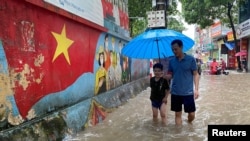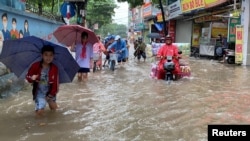Vietnam's rainy season has hit low-lying central areas, causing flash floods, landslides, inundation of thousands of homes, and crop destruction.
Experts say the severe impacts of the monsoon season have become the new norm as rapid urbanization, upstream dams, and poor drainage systems exacerbate the country's vulnerability to climate change.
Areas from the northern to the southern parts of the country have struggled to cope with heavy rains through October, but a cluster of locales have been hit the hardest, including the central coastal city of Da Nang, and the adjoining Quang Nam and Thua Thien-Hue provinces. In mid-October, officials put the natural disaster risk at its highest level in the three locations.
Nearly 5,000 people were evacuated from Da Nang, Vietnam's third-largest city on October 14. That day, flood waters reached as high as 1.5 meters in some areas of the city. Da Nang education officials closed schools October 16 because of flood threats, keeping 276,000 children home.
The stormy weather also has led to fatalities. Nine people died amid floods and landslides in September, according to the National Steering Center for Natural Disaster Prevention. In October, a 61-year-old and a 13-year-old in coastal locales were found dead after being caught in floods, and four South Korean tourists died after their car was swept away in a flood in the Central Highlands city of Dalat.
Although there are efforts to promote flood resilience, current programs fail to address the magnitude of the issue, Nguyen Hong Quan, associate professor at Vietnam National University and leader of the Institute for Circular Economy Development in Ho Chi Minh City told VOA.
"The current strategy and solutions are not enough to cope with [flooding]. We need much more than that," he said. "It is very complex. It is not an easy task."
Upstream dams
Vietnam is among the countries most vulnerable to climate change, with a 3,200-kilometer coastline and much of its population of 100 million in low-lying cities and river deltas.
"The country faces many climate-related hazards, including rising sea levels, extreme rainfall, and storm surges," wrote Vo Quang Tuong, lecturer at Ho Chi Minh City Open University who specializes in hydrology, by email.
Da Nang's efforts showcase Vietnam's struggle to increase its resilience to climate change as urban flooding increases.
"Da Nang in Vietnam is probably the best-managed city for water management. And it's extremely flooded," said Brian Eyler, director of the Southeast Asia Program at the Washington-based Stimson Center and co-lead of the Mekong Dam Monitor.
"The flooding is off the charts there," he said.
While extreme weather is the key driver of increased floods on the central coast, a cluster of dams built across the mountain range in Vietnam's Central Highlands is also a factor, Eyler said.
When major storms come into the region, reservoirs in the Central Highlands can become dangerously full. Dam operators' top priority is to protect their assets by releasing water, but this can worsen conditions in downstream Danang and surrounding locales.
"Downstream is probably already flooded or soon to be flooding, and the sudden release of water can exacerbate that," Eyler said.
Upstream dams in China and Laos also worsen flooding and contribute to droughts in the northern Red River Delta and the Mekong Delta in the South, according to Eyler, who described dams as "causing a kind of a panoply of problems."
Urban flooding
While Vietnam's central coast is often hardest hit by storms, urban flooding is frequent in densely populated cities.
"Rapid urbanization in Vietnam has led to the expansion of cities without adequate consideration of flood risk, often resulting in densely populated areas located in flood-prone areas," Tuong in Ho Chi Minh City said.
Nonstop rains in the capital, Hanoi, on September 28 and 29 caused severe disruptions to traffic across the city and left every street and alley in low-lying Hoang Mai district flooded, according to local news reports.
Similar scenes play out in Ho Chi Minh City, where anti-flooding projects lag behind schedule.
A $426 million project aimed at managing floods by building sluice gates and dikes is years behind its expected completion date. The project kicked off in 2016 and was set to be completed in three years. Beleaguered by financial and managerial setbacks, progress continues at "a snail's pace," according to a report in the local publication VnExpress.
Experts also point to waste management, sinking land, and concretization of cities as further hurdles.
Miquel Angel, on Vietnam's Tourism Advisory Board, told VOA that clogged drainage systems are "one of the biggest problems in Vietnam."
"The waste collection system is still under government hands and they don't allow any private company to interact," Angel said. "Garbage keeps ending up in the drainage holes and clogging all the holes that are going to the main system."
Quan, of the Institute for Circular Economy Development, described groundwater extraction and construction on riverbanks as causing land to sink. The lack of green space leaves little soil to absorb rainwater, he added.
"Now you see concrete everything. This also increases the volume of water going to the drains," Quan said. "With the limited capacity of the drainage combined with the extremely higher rainfall events and no impervious areas to absorb it … of course, the drainage system cannot handle it."
















